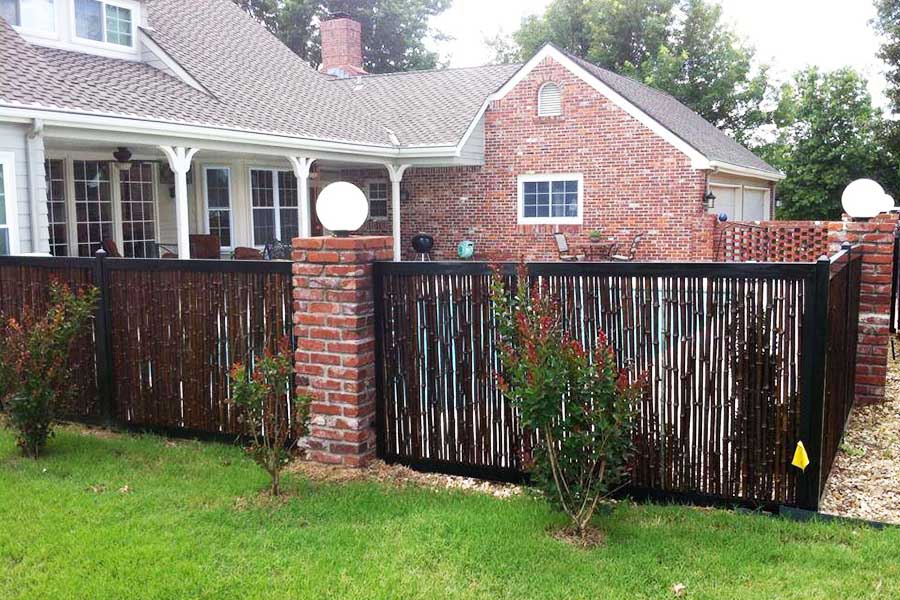All Categories
Featured
Your fencing is subjected to various climate condition year-round, and while it offers as a vital part of your residential or commercial property, it's likewise among one of the most at risk elements when it concerns weather-related damages. Rough winds, heavy rain, severe temperature levels, and UV direct exposure can all take a toll on your fencing's stability, leading to use and tear. There are a few actions you can take to safeguard your fencing and extend its life expectancy. Right here are some effective strategies to safeguard your fence from weather-related damage.
Wood Fences: While wood is a traditional selection for fence, it is vulnerable to pest, rot, and warping damage, specifically in locations with high wetness. Pressure-treated timber or cedar is extra resilient, yet routine maintenance is necessary to keep it in good condition. Plastic Secure fencing: Vinyl is an outstanding option for those searching for a weather-resistant and low-maintenance fencing. It's unsusceptible moisture, will not warp or split in the warm, and stands up to fading from UV rays. Metal Fencing: Wrought iron and aluminum are long lasting materials for fencing, yet they need a rust-resistant finish to shield them from rust due to moisture. A safety covering or regular upkeep can protect against corrosion and prolong the life of steel fences. Composite Fence: Made from a blend of timber fibers and plastic, composite fencings are very resistant to weather aspects, consisting of uv, moisture, and heat rays. This material offers a balance of durability and aesthetic allure. Picking a material matched to your climate will certainly provide far better protection for your fencing in the long term.
Seal or Stain the Wood: Using a premium sealant or stain to your timber fencing develops a waterproof barrier that stops dampness from getting in the timber. It also aids shield the timber from UV rays, which can create discoloration and drying. Reapply Sealer Frequently: With time, the safety barrier of your sealant or discolor can put on down. Depending upon your environment, it's a good concept to reapply every one to two years to keep the wood protected. This treatment will certainly maintain the fence's appearance, protect against rot, and lengthen its life expectancy.
![]()
For extra protection, take into consideration making use of wind-resistant mesh screens or panels in areas where wind is a considerable issue. This added layer can assist decrease the force that the wind exerts on your fencing.
Examine Drainage: Make sure that the ground around your fence slopes far from the blog posts. Proper drain allows water to move away from the fencing, avoiding wetness accumulation. Mount Drainage Equipments: In areas where drain is a concern, take into consideration including a French drainpipe or crushed rock around the base of your fence messages to reroute water far from the framework. Excellent drainage can protect against rot, rust, and various other types of weather-related degeneration.
![]()
![]()
Concrete Footings: Set fence posts in concrete to stop them from loosening with time as a result of soil erosion or changing ground. Steel Braces: Including metal braces to fencing articles can offer extra strength and lower the danger of damaging or leaning. Strengthening your posts guarantees that your fencing will remain in place, also during serious climate.
For wooden fences, delicately clean the surface with a mild cleaning agent to remove dust and gunk. For plastic fencings, utilize a soft cloth and cleaning option to avoid buildup. For metal fences, check for rust and sand it off before applying a fresh layer of paint. Conclusion. Your fencing is an important feature of your home, and with the best treatment, it can stand up to the challenges presented by the weather condition. By selecting sturdy products, performing routine upkeep, and strengthening weak points, you can secure your fencing from the components and extend its life. Normal assessments, using safety coatings, and taking actions to manage dampness and wind exposure will certainly help make sure that your fence continues to be strong, useful, and appealing for several years ahead.
- Select Weather-Resistant Products. The products you choose for your fence can have a major effect on its capability to hold up against the elements. Different materials are better geared up to handle particular climate condition. Below's a failure of how numerous products stand up versus the climate:
Wood Fences: While wood is a traditional selection for fence, it is vulnerable to pest, rot, and warping damage, specifically in locations with high wetness. Pressure-treated timber or cedar is extra resilient, yet routine maintenance is necessary to keep it in good condition. Plastic Secure fencing: Vinyl is an outstanding option for those searching for a weather-resistant and low-maintenance fencing. It's unsusceptible moisture, will not warp or split in the warm, and stands up to fading from UV rays. Metal Fencing: Wrought iron and aluminum are long lasting materials for fencing, yet they need a rust-resistant finish to shield them from rust due to moisture. A safety covering or regular upkeep can protect against corrosion and prolong the life of steel fences. Composite Fence: Made from a blend of timber fibers and plastic, composite fencings are very resistant to weather aspects, consisting of uv, moisture, and heat rays. This material offers a balance of durability and aesthetic allure. Picking a material matched to your climate will certainly provide far better protection for your fencing in the long term.
- Frequently Deal With Wood Fences. Safeguarding it from sunshine, wetness, and temperature level fluctuations is critical if you have a wooden fence. Timber can soak up moisture from rain, moisture, or snow, causing it to rot and deteriorate. Here's how you can secure wooden fencings:
Seal or Stain the Wood: Using a premium sealant or stain to your timber fencing develops a waterproof barrier that stops dampness from getting in the timber. It also aids shield the timber from UV rays, which can create discoloration and drying. Reapply Sealer Frequently: With time, the safety barrier of your sealant or discolor can put on down. Depending upon your environment, it's a good concept to reapply every one to two years to keep the wood protected. This treatment will certainly maintain the fence's appearance, protect against rot, and lengthen its life expectancy.

- Install Windbreaks. Solid winds can trigger substantial damage to fences, particularly those made of high structures or lightweight products. Wind can fall a fencing or create panels to change. Installing a windbreak is an efficient method to decrease the effect of gusty winds. You can create a windbreak by planting bushes, trees, or high plants near your fence. These all-natural obstacles can aid deflect wind, preventing straight gusts from harming your fencing.
For extra protection, take into consideration making use of wind-resistant mesh screens or panels in areas where wind is a considerable issue. This added layer can assist decrease the force that the wind exerts on your fencing.
- Make Sure Appropriate Drainage Around Your Fence. Standing water is among the leading causes of fence damage, particularly for wood fencings. Water can damage the fence messages, causing them to rot and weaken much more rapidly. To stop this:
Examine Drainage: Make sure that the ground around your fence slopes far from the blog posts. Proper drain allows water to move away from the fencing, avoiding wetness accumulation. Mount Drainage Equipments: In areas where drain is a concern, take into consideration including a French drainpipe or crushed rock around the base of your fence messages to reroute water far from the framework. Excellent drainage can protect against rot, rust, and various other types of weather-related degeneration.

- Trim Overhanging Branches and Vines. Overhanging tree branches and creeping plants can create damage to your fencing during storms or high winds. To safeguard your fence, trim any branches or plants that hang over or near the fence routinely.
- Enhance Fence Posts. The security of your fence largely relies on the problem of the articles. Fence posts are prone to moving, leaning, and decaying, specifically during periods of extreme climate. If your fence is in a location that ices up or experiences high winds throughout winter months, it is essential to reinforce the posts to keep stability. Some methods to reinforce your fencing messages include:

Concrete Footings: Set fence posts in concrete to stop them from loosening with time as a result of soil erosion or changing ground. Steel Braces: Including metal braces to fencing articles can offer extra strength and lower the danger of damaging or leaning. Strengthening your posts guarantees that your fencing will remain in place, also during serious climate.
- Regular Examinations and Upkeep. Routine evaluations are essential for determining early indicators of weather-related damage. Examine your fencing after tornados or heavy rainfall to try to find problems such as loosened boards, drooping blog posts, or rusted areas. Early discovery of small troubles can save you from expensive fixings in the future. In addition, cleansing your fencing occasionally helps maintain its problem. :
For wooden fences, delicately clean the surface with a mild cleaning agent to remove dust and gunk. For plastic fencings, utilize a soft cloth and cleaning option to avoid buildup. For metal fences, check for rust and sand it off before applying a fresh layer of paint. Conclusion. Your fencing is an important feature of your home, and with the best treatment, it can stand up to the challenges presented by the weather condition. By selecting sturdy products, performing routine upkeep, and strengthening weak points, you can secure your fencing from the components and extend its life. Normal assessments, using safety coatings, and taking actions to manage dampness and wind exposure will certainly help make sure that your fence continues to be strong, useful, and appealing for several years ahead.
Latest Posts
Why Choose Timber Secure Fencing from Washington Fencing Business?
Published Apr 20, 25
1 min read
Practical Carpet Take Care Of Lasting Elegance
Published Apr 20, 25
2 min read
Achieve Your Monetary Desires with WyHy's Wealth Management Solutions
Published Apr 20, 25
1 min read